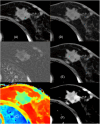Dual-Energy CT in Breast Cancer: Current Applications and Future Outlooks
- PMID: 40336872
- PMCID: PMC11935073
- DOI: 10.1002/pro6.1213
Dual-Energy CT in Breast Cancer: Current Applications and Future Outlooks
Abstract
Breast cancer is the most prevalent cancerous tumor in women, characterized by different subtypes and varying responses to treatment. The continued evolution of breast cancer diagnosis and management has resulted in a transition from a one-size-fits-all approach to a new era of personalized treatment plans. Therefore, it is essential to accurately identify the biological characteristics of breast tissue in order to minimize unnecessary biopsies of benign lesions and improve the overall clinical process, leading to reduced expenses and complications associated with invasive biopsy procedures. Challenges for future research include finding ways to predict the response of breast cancer patients to adjuvant systemic treatment. Dual-energy CT (DECT) is a new imaging technology integrating functional imaging and molecular imaging. Over the past decade, DECT has gained relevancy, especially in oncological radiology. This article proposed a literature review of the application and research status of DECT in breast cancer treatment strategy determination and prognosis prediction.
Keywords: Breast cancer; Clinical diagnosis; Dual‐energy CT; Prognosis prediction; Quantitative parameters.
© 2023 The Authors. Precision Radiation Oncology published by John Wiley & Sons Australia, Ltd on behalf of Shandong Cancer Hospital & Institute.
Conflict of interest statement
The authors declare no conflicts of interest.
Figures





Similar articles
-
Dual-energy CT quantitative parameters for the differentiation of benign from malignant lesions and the prediction of histopathological and molecular subtypes in breast cancer.Quant Imaging Med Surg. 2021 May;11(5):1946-1957. doi: 10.21037/qims-20-825. Quant Imaging Med Surg. 2021. PMID: 33936977 Free PMC article.
-
Differentiating between benign and malignant breast lesions using dual-energy CT-based model: development and validation.Insights Imaging. 2024 Jul 10;15(1):173. doi: 10.1186/s13244-024-01752-2. Insights Imaging. 2024. PMID: 38981953 Free PMC article.
-
Dual-energy CT in differentiating benign sinonasal lesions from malignant ones: comparison with simulated single-energy CT, conventional MRI, and DWI.Eur Radiol. 2022 Feb;32(2):1095-1105. doi: 10.1007/s00330-021-08159-3. Epub 2021 Aug 24. Eur Radiol. 2022. PMID: 34427744
-
Progress in the application of dual-energy CT in pancreatic diseases.Eur J Radiol. 2023 Nov;168:111090. doi: 10.1016/j.ejrad.2023.111090. Epub 2023 Sep 7. Eur J Radiol. 2023. PMID: 37742372 Review.
-
An update on advanced dual-energy CT for head and neck cancer imaging.Expert Rev Anticancer Ther. 2019 Jul;19(7):633-644. doi: 10.1080/14737140.2019.1626234. Epub 2019 Jun 21. Expert Rev Anticancer Ther. 2019. PMID: 31177872 Review.
References
-
- Giaquinto AN, Sung H, Miller KD, et al. Breast Cancer Statistics, 2022. CA Cancer J Clin. 2022;72(6):524‐541. - PubMed
-
- Chae EJ, Song JW, Seo JB, Krauss B, Jang YM, Song KS. Clinical utility of dual‐energy CT in the evaluation of solitary pulmonary nodules: initial experience. Radiology. 2008;249(2):671‐681. - PubMed
-
- De Cecco CN, Darnell A, Rengo M, et al. Dual‐energy CT: oncologic applications. AJR Am J Roentgenol. 2012;199(5 Suppl):S98‐S105. - PubMed
-
- Lennartz S, Le Blanc M, Zopfs D, et al. Dual‐Energy CT‐derived Iodine Maps: Use in Assessing Pleural Carcinomatosis. Radiology. 2019;290(3):796‐804. - PubMed
-
- Agostini A, Borgheresi A, Mari A, et al. Dual‐energy CT: theoretical principles and clinical applications. Radiol Med. 2019;124(12):1281‐1295. - PubMed
Publication types
LinkOut - more resources
Full Text Sources
Miscellaneous
